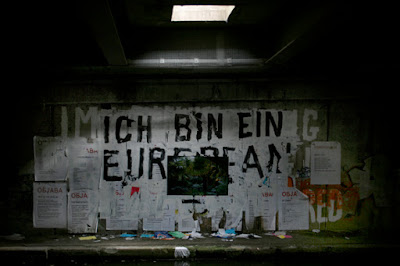 |
All Images: Work In Progress. Acrylics, Paper Collage, Ink, Spray Enamel, Adhesive Tape,
Pencil, Coloured Pencil, Ballpoint Pen, Various Solvents & Screen Print On panel. Leicester
Print Workshop, July 2016 |
Like most
artists, I spend a lot of mental energy reflecting not just on what my work may
or may not express, but the nuts and bolts of how it might do it too. In fact, for many, the desire to explore a
particular medium or range of technique may often be sufficient motivation alone
to embark on a particular project - whilst the more nebulous stuff takes care
of itself, (or is taken care of by others).
I’d estimate
that, for me, considerations over why
I’ve made something and how I’ve gone
about it are in a roughly equal balance currently. Actually, what interests me particularly is
that the two things seem to be blurring into each other quite a lot. Thus, the list of possible themes that might
run through current efforts, itself includes ideas about hybridisation; the
mutation of images, or their recycling or translation through different forms;
and the ways that Process and the technologies of production might rub up
against potential meaning.
If that all
sounds a bit grand or over-cerebral, let’s just say I’m really enjoying
exploring new media, these days, - whenever the opportunity arises. We all end up with our own favoured ways of
working, but it seems healthy to consider any medium as, at least available; possibly
appropriate; ideally of equal validity; and most definitely - an opportunity to
explore exciting new territory. My forays into screen-printing definitely fit that agenda, and are something I’ve already discussed here in recent months.
I have much respect for the wealth of skill and experience I’ve witnessed around me on recent visits to Leicester Print Workshop. However, I’ve probably always suspected I’m less likely to become a purist
printmaker (admirable though that is), than to be searching for ways to
incorporate print into hybridised forms - or as one facet of a multidisciplinary practice.

In a small way,
the images here illustrate that impulse.
They feature my recent attempts to print onto a series of small panels -
already prepared using my familiar (and itself somewhat hybridised)
painting/collage procedure. The chosen
motifs were themselves extracted digitally from three different photographs,
thus building in another layer of process, and a set of four stencils produced
which could be combined in a slightly different way each time. What I ended up with is a series of eight
pieces, (actually it’s two sub-series of four with some crossover between) in
which certain motifs recur in varying configurations. It’s really just another take on that, ‘The Same But Different’ shtick, I’ve
been harping on about for a while.

There were one or
two practical issues to get around, and I should thank Kate the LPW Technician
for her input at this point. In fact,
the trickiest connundrum was something I hadn’t predicted - involving the PVA
on my panels being remoistened just enough, by the application of ink, that
some wanted to glue themselves to the screen.
Luckily, a solution was found and the whole set of eight panels
completed over one afternoon of prepping screens and sussing-out - followed by a
marathon nine-hour session of pulling prints, cleaning screens and repeatedly
changing colours. Trust me to choose the
two hottest days of the year!
 |
| No Need To Wait For Stuff To Dry On The Hottest Day Of The Year. |
Anyway, it’s all been worth it as I’m generally
pleased with the overall result. If nothing
else I’ve proved to myself that it’s a perfectly feasible thing to attempt, and
is a method I might exploit further in future projects. Most importantly, bar a bit of final
titivating, it means I now have at least four separate, but related, series of
work from which to select for the exhibition I’ll hang with Shaun Morris and
Andrew Smith, in a few weeks. It’s good
to know there should be no last minute concern over quantity, leaving a bit of
much-needed time/energy to focus on the other practicalities of getting a show up. We’ve agreed a title (all will be revealed),
and are starting to gear up over supporting material, publicity, etc. Watch this space...

















































